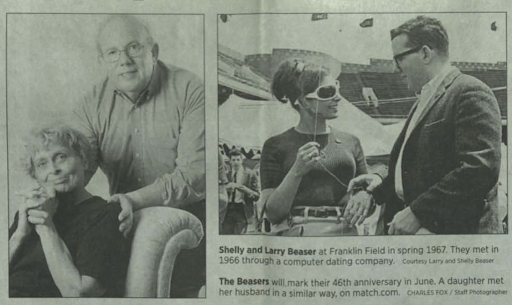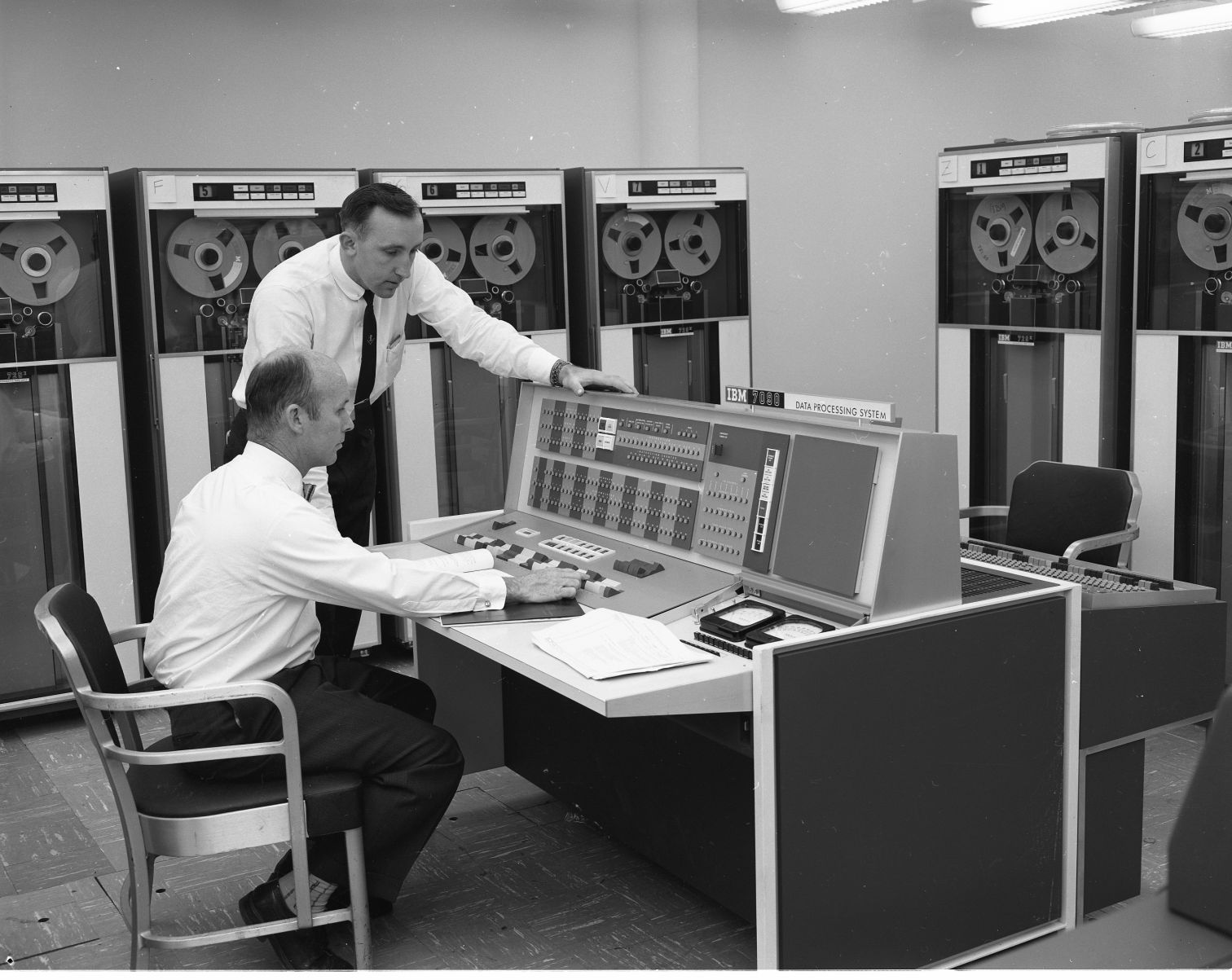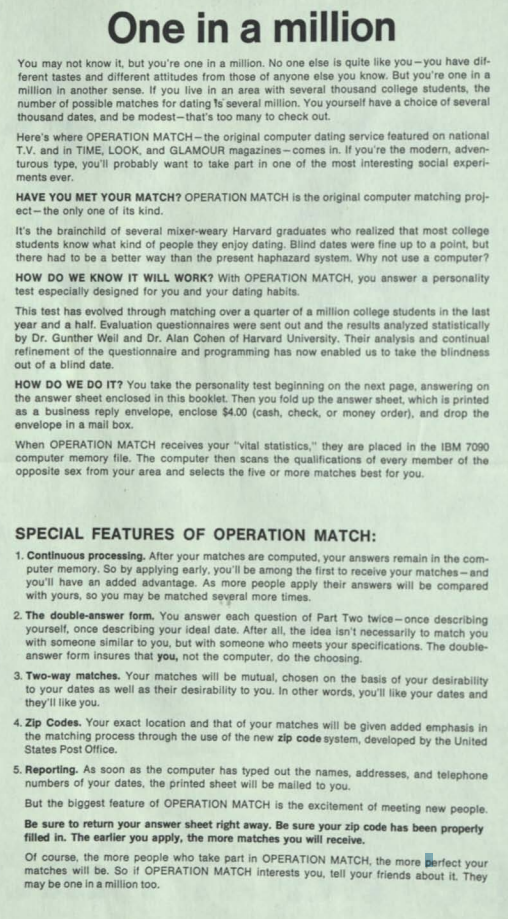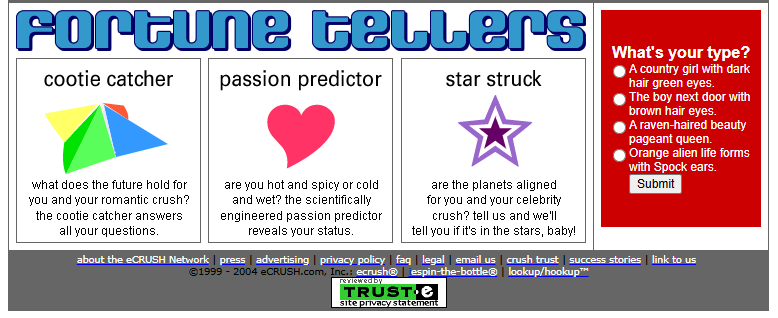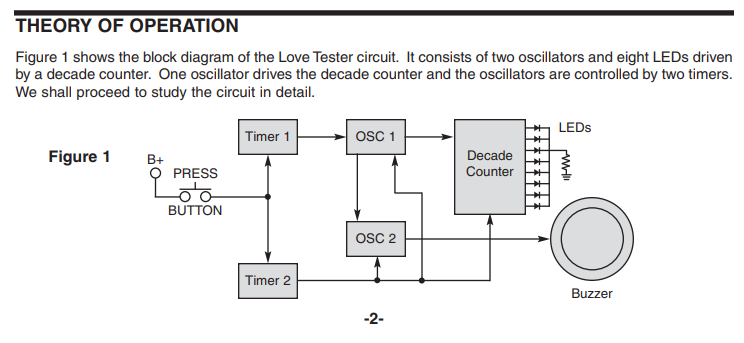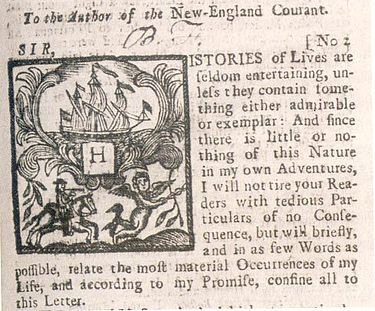created 2025-04-03, & modified, =this.modified
rel: Shapely Ankle Preferr’d by Francesca Beauman
Title
A lot of what I am curious about is using technology as a surrogate for a feature we already have. So a pre-written card, to speak the words we cannot say – or an algorithm that will tell us who we love. Love, for all it sometimes feels absent, is one thing we have – it’s curious we we would delegate this task.
In 1920s, dating as we know was a new thing for middle-class Americans.
Dating largely replaced “calling,” a practice during which a young man would come to a young woman’s home.
Once there he would sit her her parlor, be served refreshments and perhaps listen to her play the piano.
In a 1940 article in the Woman’s Home Companion noted, “The modern girl cultivates not one single suitor, but dates, lots of them…. Her aim is not a too obvious romance but general popularity.”
Calling
The earliest uses of calling cards, or at least something like them, reach as far back as the ancient Egyptians, who left ceramic tiles in their temple of worship
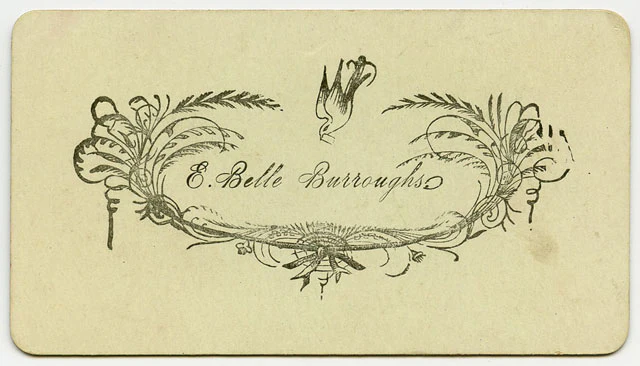
Calls were much more than casual visits; the custom helped cement one’s position in society. The rules of calling were precise and strict, but it was essential to navigate the bewildering process with ease lest you commit an unforgivable faux pas: “Calling is so intimately interwove in society’s law, that not to know when to call, how to call and on whom to call, would be an unpardonable breach of etiquette.”
A call lasted for no more than ten to fifteen minutes. If the person was unavailable they left a calling card, typically on a silver tray. The receiver reciprocated if they wanted to continue the social relationship.
Ladies typically kept their calling cards in cases in their purses or handbags
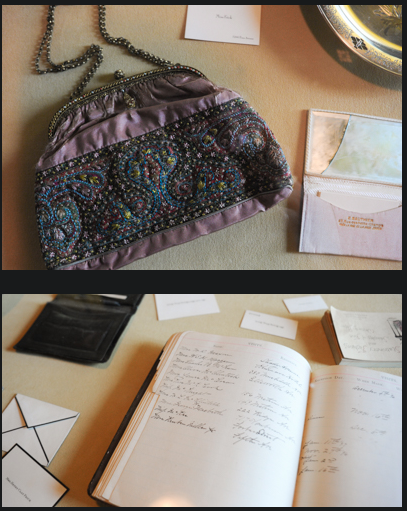
Dating
The earliest usage of the noun “date” is in 1896 by George Ade, a columnist for the Chicago Record. Date referred to “public” courtship, when a woman would meet a man publicly rather than privately at a residence or at court. In Ade’s 1899 “Fabels in Slang”, he used the term “Date Book” to describe a type of ledger system a cashier used to track dates with suitors until she married.
Technology
- Video dating systems of the 1980s and 1990s especially, where customers gave a performance on (typically VHS) video, which was viewable by other customers, usually in private, in the same facility. Some services would record and play back videos for men and women on alternate days to minimize the chance that customers would meet each other on the street.
- Online dating
Computer dating systems of the later 20th century, especially popular in the 1960s and 1970s, before the rise of sophisticated phone and computer systems, gave customers forms that they filled out with important tolerances and dating preferences, which were “matched by computer” to determine “compatibility” of the two customers..
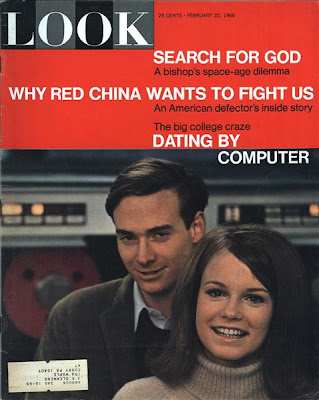
Scientific Marriage Foundation and George W. Crane
The first large-scale computer dating system, The Scientific Marriage Foundation, was established in 1957 by Dr. George W. Crane. In this system, forms that applicants filled out were processed by an IBM card sorting machine.
Applicants would fill out forms, provide character references and photographs, and interview a local counselor of the foundation, who would provide an assessment of the candidate. The information was sent to the foundation in Mellott, Indiana, which would process the data with an IBM sorting machine, and pair up men and women according to their expected compatibility.
Tests for Husbands and Wives
They seem to have produced this document.
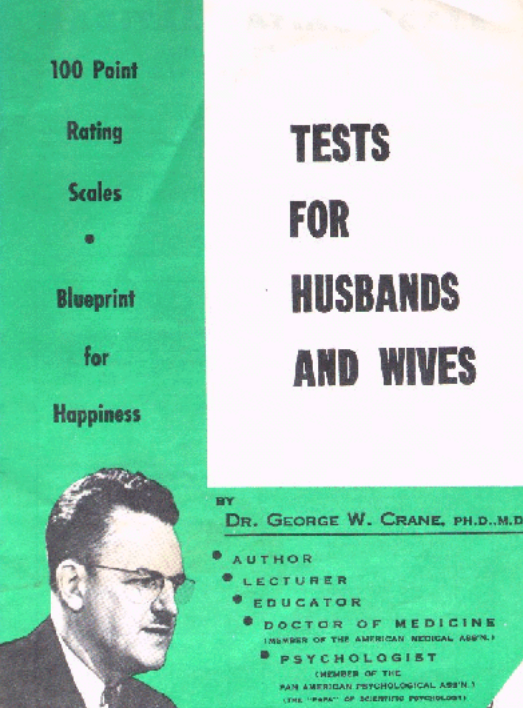
- Stares and flirts with other women while out with wife
- Brings home guests without warning
- Polite and mannerly even when alone with his wife.
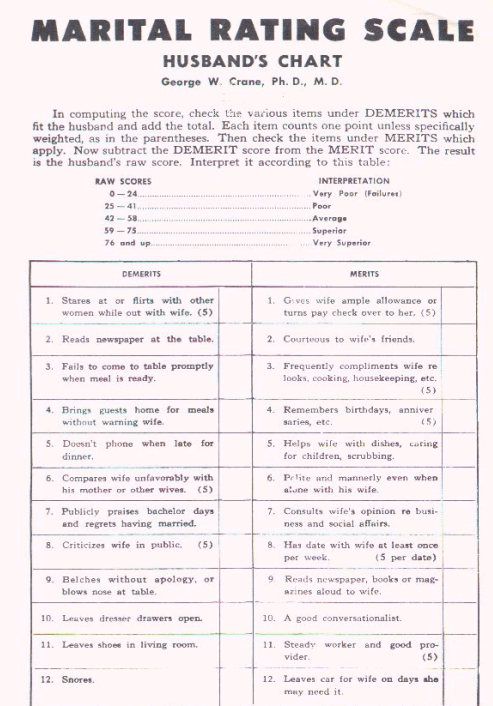
The Wife version
- a good hostess
- is a back seat driver
- is suspicious and jealous
- squeezes tooth paste at the top
- fails to wash top of milk bottle before opening it
- bravely carries on during financial depression
This test represents the composite opinions of 600 husbands when asked to list the chief merits and demerits of their wives. They talked frankly. I have summarized the most frequently voiced flaws and virtues and have weighted those items which, in my judgement as a psychologist and a physician are especially important in marriage. I commend this test to the attention of all intelligent women who aspire to make their marriage both permanent and happy. Young women contemplating matrimony might very profitably use this tests as a practical guide.
Computerized Dating Services
The earliest commercially successful computerized dating service in either the US or the UK was Com-Pat, started by Joan Ball in 1964. Operation Match, started by Harvard University students a year later is often erroneously claimed to be the “first computerized dating service.” In actuality, both Com-Pat and Operation Match were preceded by other computerized dating services in Europe—the founders of Operation Match and Joan Ball of Com-Pat both stated they had heard about these European computer dating services and that those served as the inspiration for their respective ideas to create computer dating businesses
Com-Pat
Joan Ball was a British businesswoman who started the first computer dating service in England.
In 1964, Ball changed the name of her marriage bureau to the St. James Computer Dating Service, and the bureau ran its first set of computer match ups in 1964. Ball used a time-shared computer and acquired a matching program that would pair couples based on questionnaire responses. This made Ball’s service the first commercially successful computer dating service in either the UK or the US.
Operation Match
Operation match was a computer dating service created in 1965 by three Harvard undergrads.
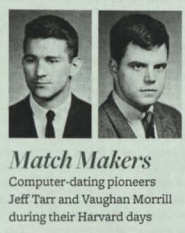
Originally it was meant to pair Ivy league men with women from The Seven Sisters (Barnard, Bryn Mawr, Mout Holyoke, Smith, Wellesley, Vassar, Radcliffe).
Participants filled out a 75-point questionnaire, covering hobbies, education, physical appearance, race and attitudes towards sex, that could then be mailed with a $3 fee.
Questions
- do you believe in a God who answers prayers?
- is extensive sexual activity in preparation for marriage part of growing up?
Without being able to break even they attempted to promote by adding celebrity star Vicky Albright to the dating pool. “Registrations doubled in the week before the deadline.”
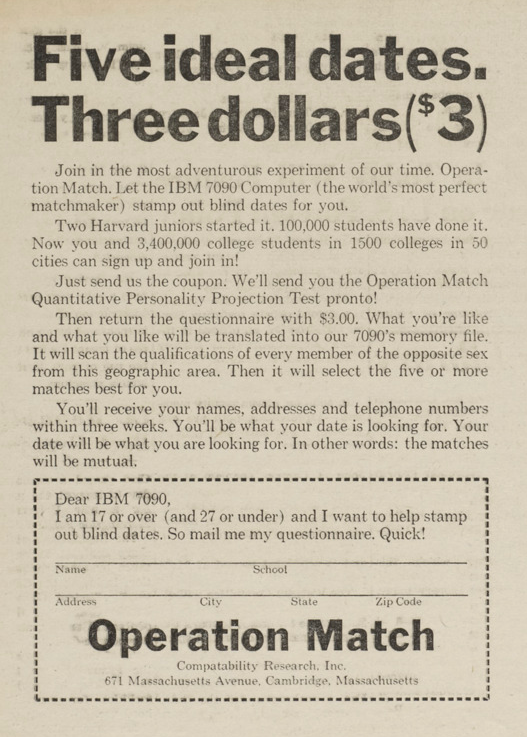
In an interview with Harvard Magazine, Tarr recalled that they would send people a letter “saying who they were matched to, with phone numbers,” with one woman at Vassar receiving over 100 matches (including one with her roommate).
The questionnaires were transferred from paper to punched cards and processed on an IBM 7090 computer at the Avco service bureau in Wilmington, Massachusetts. About a week later, each participant received mail with an IBM 1401 printout containing names and telephone numbers for five potential matches.
Elated, Tarr rented a middling-capacity computer for $100 an hour (“I couldn’t swing the million to buy it.”), fed in the coded punch cards (“When guys said we sent them some hot numbers, they meant it literally.”) and sped the names of computer-picked dates to students all over New England.
IBM 1401 printout looks like this.
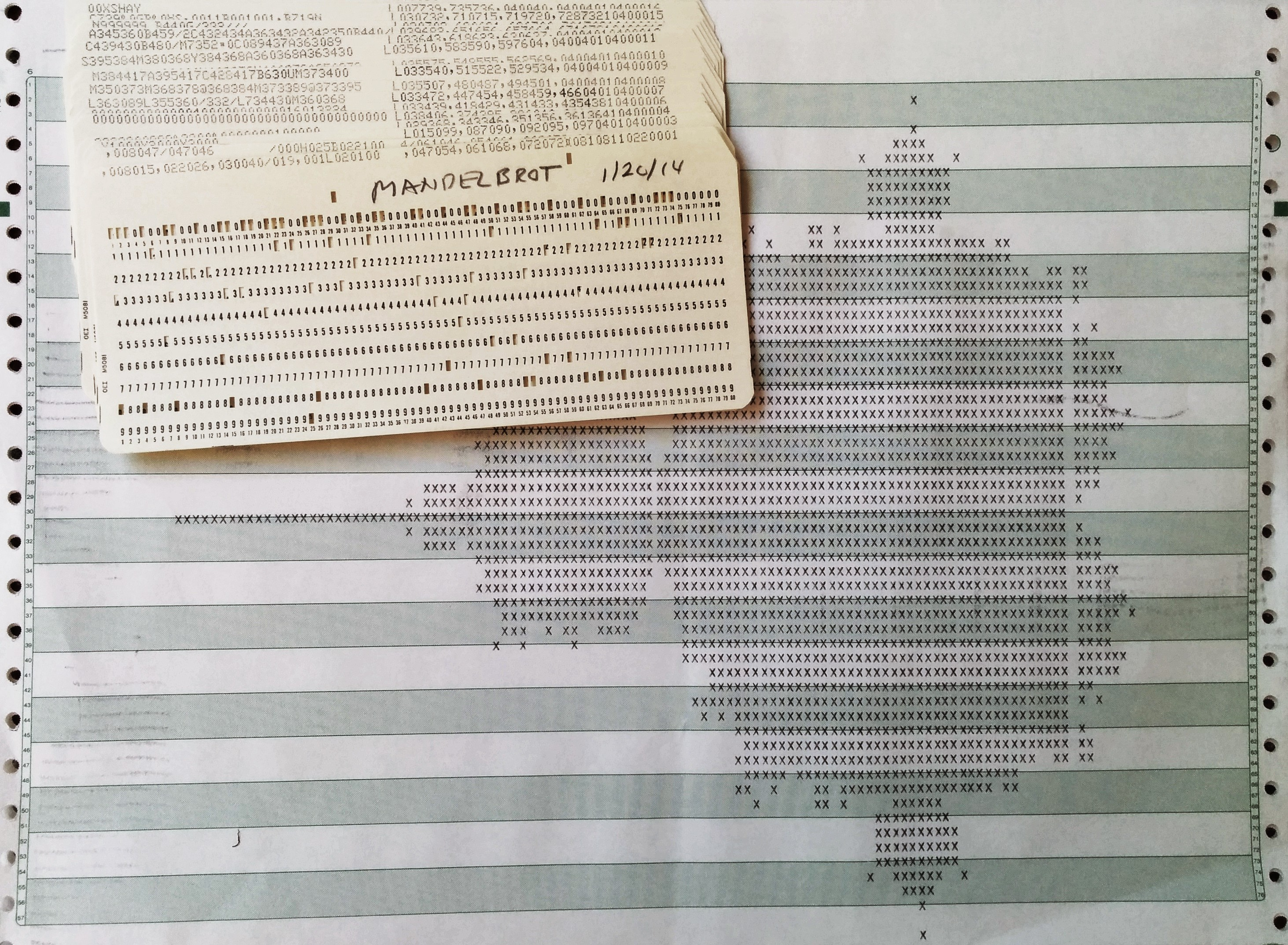
Approximately 90,000 questionnaires were completed after six months of launch, with more than 100,000 respondents paired.
One female student at Vassar received over 100 matches.
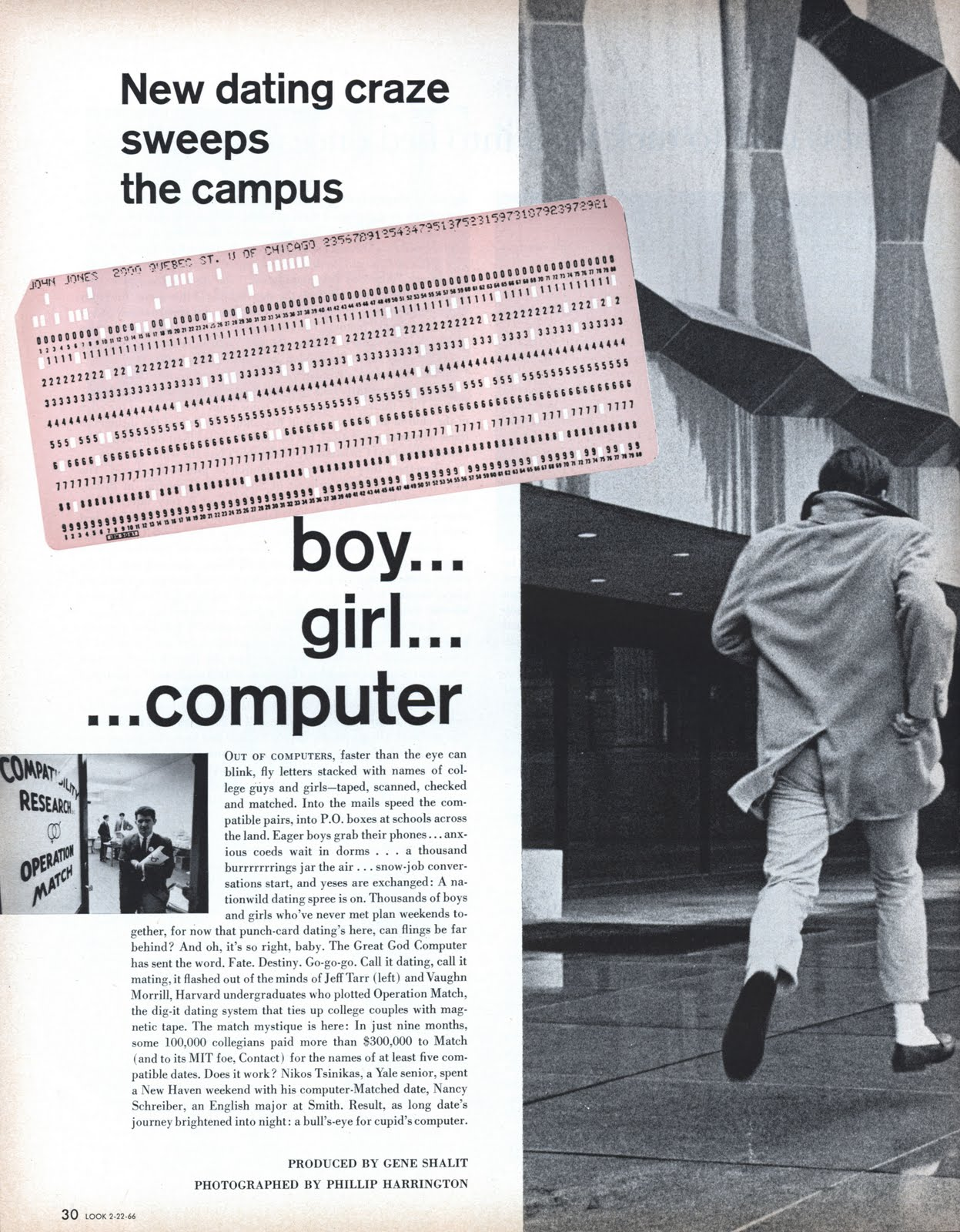
One of the creators of Match, an aspiring songwriter came up with this song
Well, I filled out my form and I sent it along,
Never hoping I'd get anything like this.
But now when I see her,
Whenever I see her,
I want to give her one great big I.B.M. kiss.
She's my I.B.M. baby, the ideal lady,
She's my I.B.M. baby.
From the first time I met her I couldn't forget her,
She's my I.B.M. baby.
Well we've dated sometime,
Things are going just fine, and I'd like to settle down with her.
Just like birds of a feather
We put 2 and 2 together, and we came one with an I.B.M. affair.
She's my I.B.M. baby, I don't mean maybe,
She's my I.B.M. baby.
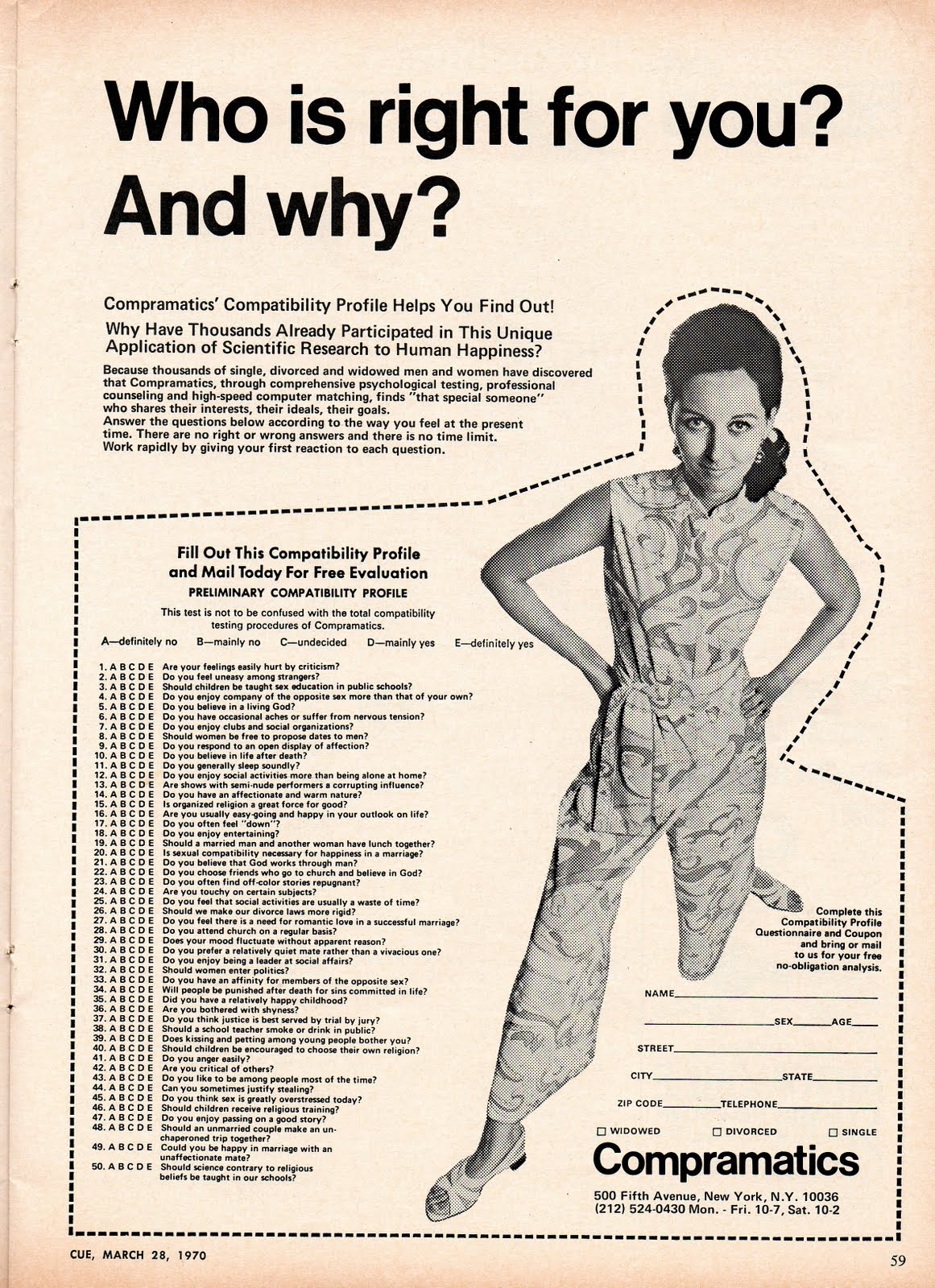
Images from Computer History PDF
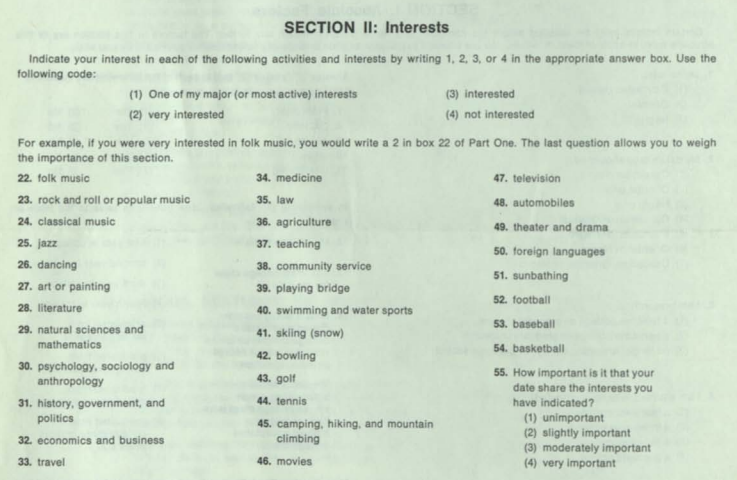
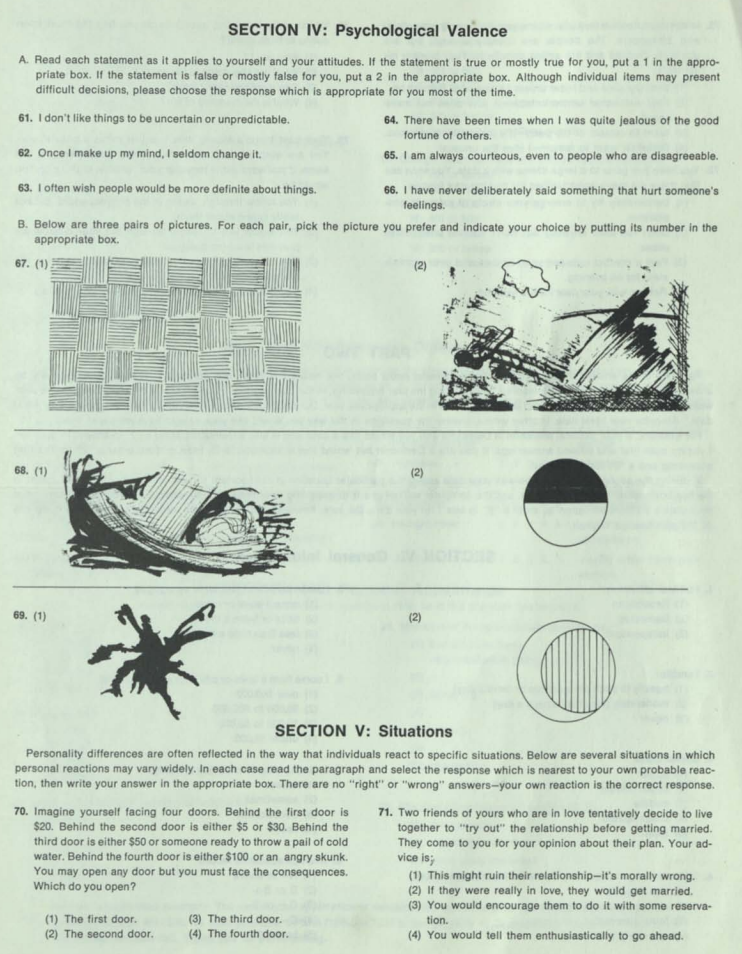
News Clips
OPERATION MATCH has produced more than its share of fun dates.—TIME MAGAZINE Computer dates are sweeping canvus, replacing old fashioned boy-meets-girl devices; punch bowls are out, punch cards are in.— LOOK
The Computer takes over in one more area—automated dating is the new fad on campuses across the country.—GLAMOUR
Electronic computers to match up married couples were recommended as a logical approach by Dr. L A. Burch, psychologist and Director of the Circuit court (Cook County) Conciliation Service— CHIC. DAILY NEWS
It reduces the anxiety of the blind date; you know that the girl wants to go out with someone roughly like you.—DR. BENSON R. SNYDER. CHIEF PSYCHIATRIST M.I.T.
It uncanny..,lt was like instant rapport. recommending OPERATION MATCH to all my unmarried friends. —MRS. M. P. (CHICAGO MATCHBRIDE)
it was something like having an Aunt Tillie who says she has a girt for you to take out. Only this time, Aunt Tillie was IBM. —MR. N. B. (NEW YORK MATCHGROOM) I went out with my first MATCH date—and E..A SAN FRANCISCO REGISTERED NURSE AND SOCIAL WORKER.
I found OPERATION MATCH to be a welcome solution tor people like myself Who are “tied down” With work and grad school.—MARY B.. BOSTON SCHOOL TEACHER.
My first MATCH date and I are still dating. and we hope to get married in June of 1967. We have only known each other for three months, but we both feel that we have known each other so much longer. We share such a large number of interests that we can’t get over the idea that we were matched so well with each other.—MARY R., SILVER SPRINGS, MARYLAND.\
Glamour Article Excerpts
The question people ask us most often about Match is how it came about. The truth is that it just happened. A little over a year ago my roommates and I were sitting around discussing dating in general, and blind dates in particular. It seemed to us that a very extensive but unsophisticated method of “fixing up” one’s friends with each other had become an accepted way of meeting people on campuses everywhere. The results were often painful for everyone concerned, because your friends of the same sex don’t really know what makes you compatible with a member of the opposite sex. They project their own feelings into the situation with great subjectivity.
The essential idea behind Operation Match is the pooling of resources into the biggest little black book ever, and using a computer as a clearinghouse for the information. At the time the idea seemed like a natural for college students who have learned to avoid the cattle shows known as “mixers.” We didn’t really know then how right we were.
Odd Combinations
We hear a lot of stories, most of them probably true, about odd combinations we’ve created. One couple that was matched had been going together for a long time and had just broken up. A girl at Michigan State was matched up with her roommate’s steady boyfriend. And a girl who mistakenly coded herself as a boy was matched with her own roommate.
(from another article) A Vassarite who was sent the names of other girls demanded $20 for defamation of character. A Radcliffe senior, getting into the spirit of things, telephoned a girl on her list and said cheerfully, “I hear you’re my ideal date.” At Stanford, a coed was matched with her roommate’s fiancé. Girls get brothers. Couples going steady apply, just for reassurance.
Thought
The terminology here, apply.
An interesting fact is that about twice as high a percentage of girls have suggestions than boys. More boys, however, have comments.
Continuous Processing
Our present system of “continuous processing” enables us to keep applications on file until the end of the academic term. That is, as new people apply they are matched against previous applicants as well as other new ones. So a person who applies early may get match lists as often as every two weeks. We have a lot of ideas for the future, too, some of which will be implemented as early as this coming September. Pretty soon we hope to install our first Date Machine. This will consist of a coin-operated keyboard on which anyone desiring a date for the evening will merely code the answers to some questions. Within seconds the keyboard will automatically type out the name of a match-date who is free for the evening, nearby, and has also registered as wanting a date.
Consequences
Match, now graduated to an IBM 7094, guarantees five names to each applicant, but occasionally, a response sets cupid aquiver. Amy Fiedler, 18, blue-eyed, blonde Vassar sophomore, got 112 names. There wasn’t time to date them all before the semester ended, so many called her at her home in New York. “We had the horrors here for a couple of weeks,” her mother says laughingly. “One boy applied under two different names, and he showed up at our house twice!”
Spark
“Some romanticists complain that we’re too commercial,” he says. “But we’re not trying to take the love out of love; we’re just trying to make it more efficient. We supply everything but the spark.”
Actually, computer dating supplies more. According to Dr. Benson R. Snyder, MIT’s chief psychiatrist, it acts as a method that society condones for introducing a girl and a boy. “A boy knows that the girl has expressed her willingness to date by the act of joining. I think that’s one of the most important things that it provides. It reduces the anxiety of the blind date; you know that the girl wants to go out with someone roughly like you.
Deception
“What troubles me about all this computer jazz,” says a sophomore at Connecticut College, “is my feeling that boys don’t level when they fill in their questionnaires. I was honest with mine, but I wonder if some guys fill out theirs to see if they can get a first-nighter.”
Contact
DeWan, a brilliant math and engineering student, does not have an organization as sprawling or yeasty as Tarr’s. In fact, he has no organization at all. A frugal man, he runs deep in the black: He has no full-time employees. His office is a room in his grandparents’ home, near Cambridge. He uses a Honeywell 200 computer at three o’clock in the morning, when the rental is low. In one distribution of questionnaires, he drew 11,000 responses at four dollars each.
DeWan has been going steady with a girl at Wellesley, so when he organized Contact, they put themselves to the test. Sure enough, the computer matched them. But the computer also matched her with an Amherst boy, who won her away. “It was very sad,” says DeWan, “but it proved my system works. It found her a more compatible guy.
“I was a little bit appalled by its 1984 overtones, but was much less concerned after we talked.
“Until body chemistry can be inputed into the computer to stimulate the actual reactions of two persons, I have my doubts concerning the efficacy of the method.”
Dr. Snyder agrees that the computer can’t predict compatibilty. “But it’s not just chemistry,” he insists. “It’s because you can’t program something as complicated as the whole cluster of feelings and associations that surround a boy’s notion of what a girl ought to be. What a computer can do is increase the probability of a satisfactory relationship by removing incompatible persons.”
Just the same, Tarr feels the future belongs to the computer. He’s working on campus installations of hundreds of special typewriters, all linked to a centralized “mother computer.” A boy, typing his requirements, will receive in seconds the name of a compatible girl on his campus who’s free that night. Tarr is also organizing a travel service. On deck: a transatlantic cruise by an ocean liner packed with compatible couples
Boston Globe Excerpt
“The way I envision things, in 50 years computers may well have reduced our work week to zero hours,” he told the Sarasota Journal. “We’ll date through computers, mate through computers, select our home with the help of computers, and plan our recreation with computers. It will be a fantastic time and my company and I hope to be a large part of it.”
“Back then I was going out with a girl from Wellesley,” he recalled four decades later. “1 gave her a free questionnaire, because she helped me distribute in the dorms there. When we ran it through the computer, she and I matched. That was exciting! But I forgot that she also received five other matches, including a guy from Amherst, whom she later dumped me for.”
The New Yorker Article Excerpts
Robert Ross, 1964 and Project TACT - Technical Automated Compatibly Testing - NYCs first computer-dating service.
Society—family, tribe, caste, church, village, probate court—established and enforced its connubial protocols for the presumed good of everyone, except maybe for the couples themselves. The criteria for compatibility had little to do with mutual affection.
Romantic love… “as much as it may have evolved, in the human animal, as a motivation system for matefinding, it was rarely given great consideration in the final reckoning of conjugal choice.”
An engineer named Amarnath Thombre oversees Match’s base algorithm, which takes into account fifteen hundred variables: whether you smoke, whether you can go out with a smoker, whether your behavior says otherwise. These are compared with the variables of others, creating a series of so-called “interactions.” Each interaction h., a score: a numerical expression of shav trait-tolerance. The closest analogy. Thombre told me, is to Netflix, w! uses a similar process to suggest mm you might like—“except that the me doesn’t have to like you back.‘
The Odd Couple - Gloria Hallelujah
The premise for this episode involves a computer dating service, so I decided to watch it. TACT transferred multiple choice answers to a punchcard read by IBM 1400 series.
The episode’s description:
Exaggerating on his computer dating service application, Oscar gets matched up with Felix’s ex-wife Gloria.
The service used is done through mail, and is called “Executron” - “where the wealthy meet the health.” Deceit is there from the start where the main character lies about his name, and exaggerates culturally positive characteristics.
A remark is made “computer dating is a time tested way of getting people together” and “you deserve something better, that will develop into a relationship by two people who are connected not only by the stars, above but computers below.”
Another good quote, “you’re going to foul up the entrie computer mechanism, you’re lying.”
In the end it turns out he matches with his roommates ex-wife, who was also lying. The “date is of a computer error.” He fixes it, then matches with another woman he knows already, from the beginning of the episode.
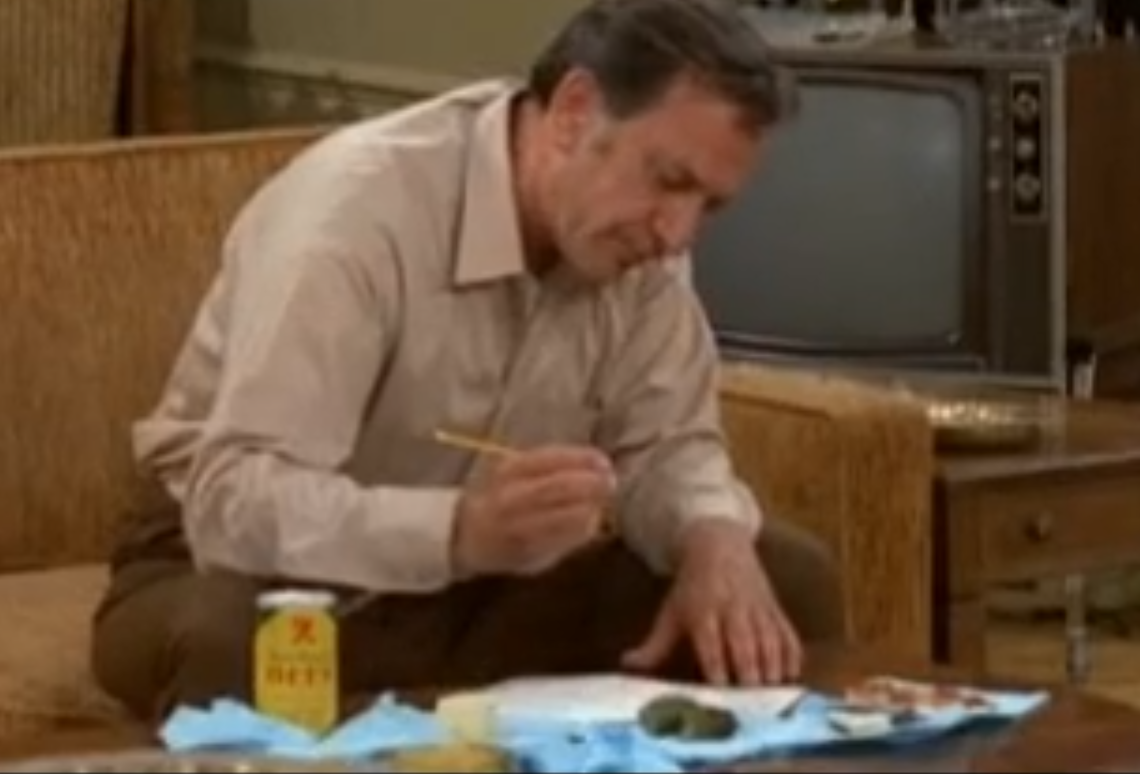
From Wired:Lovegety
Blur and Babble
Link to originalThought
In my exploration of anti-things and Holes and Survey of Shadows I’ve explored this concept that keeps on coming up in my mind (anti-dates). I might have mentioned this before. But I also in reading also encountered an anti-date kind of experiment that never happened. I was trying to read information exploring virtual spaces and architecture that is virtual (or composed of words/information etc - not constrained by reality (besides digital constraints of reality).
It was in this anthology “Disappearing Architecture” It was this building/art project called Blur, and blur was this building that was amorphous (shrouded in this mist, sourced from the lake it resided over). When you enter the idea was it was this acoustic space (far as I can tell) where the general reality references are erased. There was water available (so visitors could “drink the building”) This is all fairly interesting (and ridiculous) but the reason I brought it up is this anti-date they had planned (but was not implemented).
A sister project within the Blur project was called Babble. I’m trying to recall this from memory.
With feature babble, a proximity based network with hookups to clothes, a raincoat that provides 6th sense and a social radar of anonymous intimacy. Everyone would don these “braincoats” which would have different tactile and networked functions. Visitors were prompted with certain binary choices (like on a dating profile) and responded. These were networked in a database. When close, the raincoats color, simulating a blush. there is also a personalized acoustic sound, that increases with proximity to a match, they can choose to either approach or track or hide from this match. In the case of a 100% affinity, a small vibrating pad is embedded in the pockets of the braincoat. The motors send vibrations to the coat, mimicking the tingle of excitement that comes with human contact.
I really like that last idea (like the idea of walking, an like butterflies in the stomach, you encounter someone and there is a connection and it is like a butterfly under your shirt, thrumming and attempting to get out and connect). I kind of want to do something with that.
This was in Switzerland and that last part wasn’t implemented but I find an experiment like this such a fun way of interacting on a social way.
The creators also referenced this work I had not heard of but need to do further research on. They said it was a bit of a craze in Japan in the 90s, called the Lovegety:
“Lovegety was a proximity matchmaking device introduced in Feb. 1998 in Japan by Erfolg Co.,ltd., which allowed users to find potential dates that match their personal preferences in the vicinity” - Erfolg comes from the German word, success.
Just something I am thinking about playfully
The egg-shaped device comes in male and female versions. One has a blue underside and the other pink, and they are small enough to fit in a hand.
Owners can set the device to show display lights according to whether they are in the mood for a simple chat, ready to sing karaoke, or want to go all the way up to the “Get2” mode, in which anything the couple wants goes.
When a male Lovegety and a female Lovegety come within 4.5 metres (15 feet) of each other, a high-pitched bleeper goes off, alerting the owners to a possible rendezvous.
I’ve purchased multiple Lovegety devices after learning about this, as an odd historical relic.
The official one I purchased has a link to a site that I was able to return to via the waybackmachine.
To make the matchmaking easier, the company has opened an Internet site where Lovegety holders can post where they will be hanging out: “I’m on the Yamanote line, taking the 4:15 train from Shinjuku to Shibuya,” or, “I’m at the Giants baseball game with 60,000 other fans.”
Behold, Interland
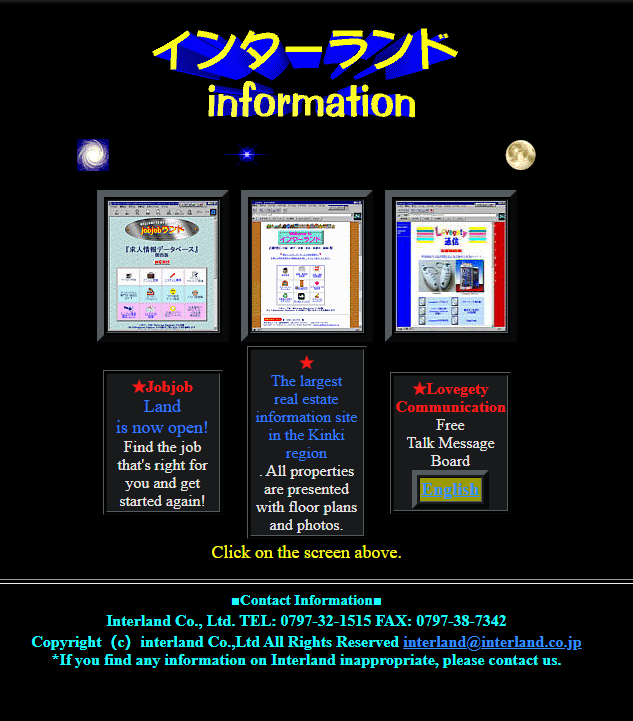
On the page is some text which I able to translate as New Red Thread Legend referring to the Red Thread of Fate myth of connection?
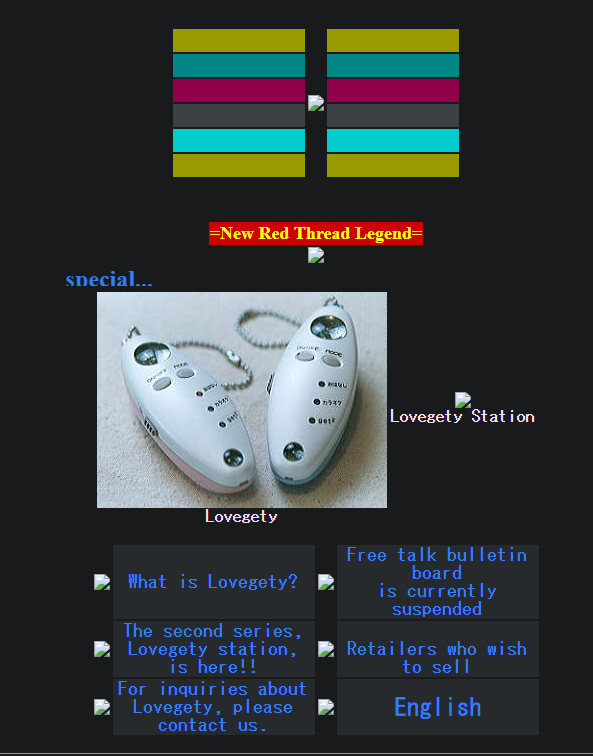
Red Thread of Fate
Red Thread of Fate
created 2025-05-02, & modified,
=this.modifiedThe Red Thread of Fate, also The Red Thread of Marriage is an Eastern Asian belief originating from Chinese mythology.
An invisible red cord is held around the finger of those destined to meet, as they are their “one true love.”
Yue Lao is the god of marriage and love. He appears as an old man under the moon. Yue Lao appears at night and “unites with a silken cord all predestined couples, after which nothing can prevent their union.”
The thread used to be attached on the male thumb, and the female little finger but it is common in modern times to be depicted tied around the fingers, often the little finger.
Yue Lao Legend
During the Tang dynasty there was a young man, named Wei Gu. He saw an old man reading under the moonlight. The man said
I am reading a book of marriage listing for who is going to marry whom. In my pack are red cords for tying the feet of the husbands and wife.
He saw an older woman carrying a young girl, and said “this little girl will be your wife in the future.” This is a strange thought, and he orders the girl stabbed by his servant with a knife.
Note
Fucking hell
Fourteen years later, Wei Gu is given the governor’s daughter in marriage. She was having difficulty finding a suitable match because though she is beautiful, she has a scar on her back.
Link to originalAfter ten years and three children later, Wei Gu sought the old man for suitable matches for his two younger sons and daughter. The old man refused to find suitors for his children. During the later years, Wei Gu sought to find a possible match for his children but by coincidence, no marriage was put to work.
Reciprocity.io and Questionnaire Sites
Users checked boxes of things they wanted to do with their friends. They were only notified when there were matches.
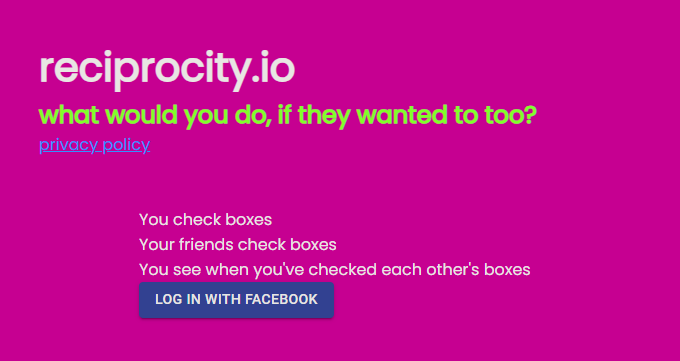

Similar sites existed where you would be notified someone has a crush on you, and then enter email addresses of the people you had crushes on.
Ecrush
eCRUSH opened in 1999 and pre-dated other social network sites.
eCRUSH.com was a teen-oriented anonymous matching site designed to obviate fears of unrequited love. A user created a list of people he was interested in, and had the option of sending anonymous emails to those individuals indicating that an unidentified person had a crush on them. The recipient could then log on to the site and create a list of people they were interested in. If the two people selected each other, then the system notified them of the match. This system is a type of viral marketing in which awareness of the site spreads among friends and acquaintances similarly to a virus as they list each other as crushes and send emails.
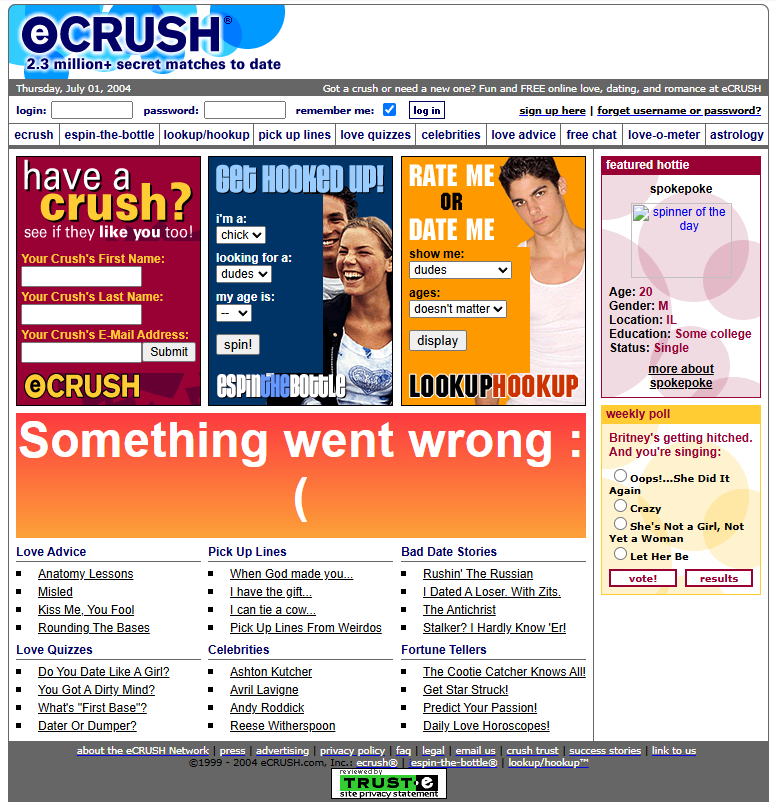
Of course, all of these are easily exploitable.
Thought
The main idea here seems to be social avoidance of uncomfortable situations. It’s directed, but not direct; it’s passive.
On WeShouldTryIt operates on the same kind of blind system, where partners are able to answer questions about sex fantasies and receive only matches.
The basic questions are things like
- take picture of us having sex
- use mirrors And there’s an advanced section with questions
- Be struck with a canes
- Be a Gorean master for partner
- Act as furniture to be used by partner
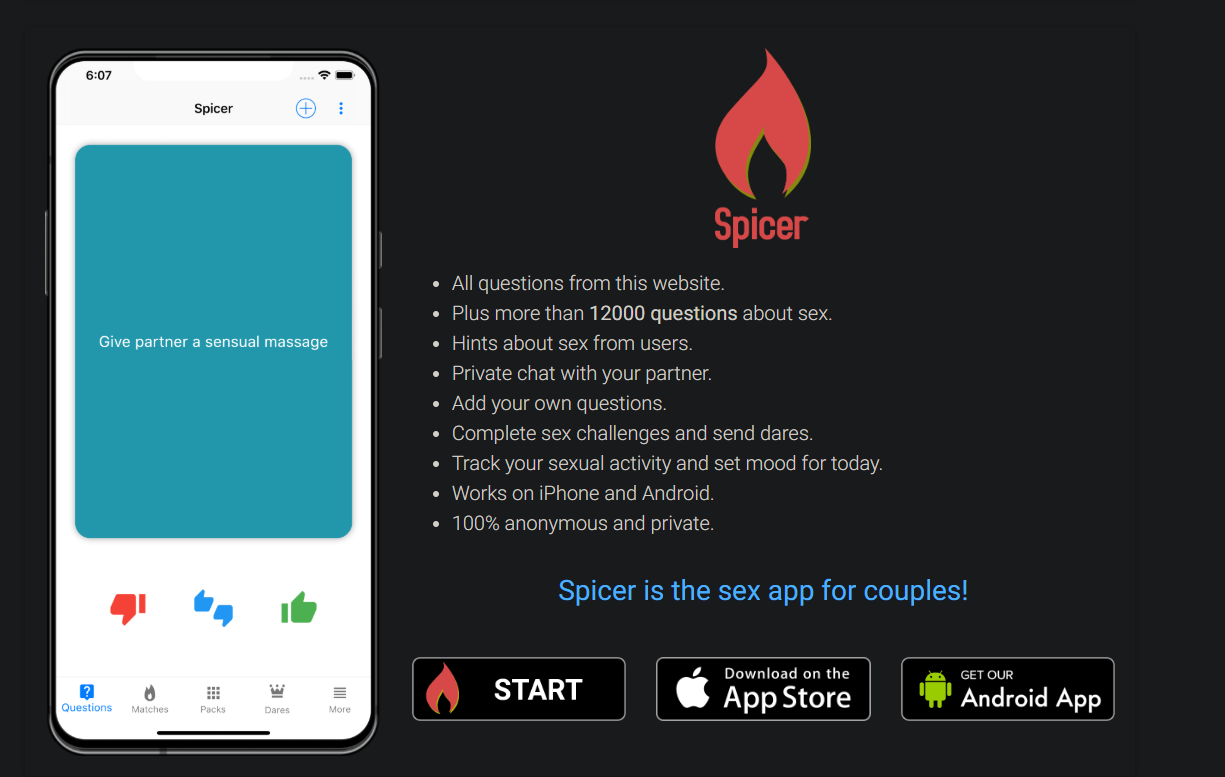 They also seem to have an encrypted gallery app.
They also seem to have an encrypted gallery app.
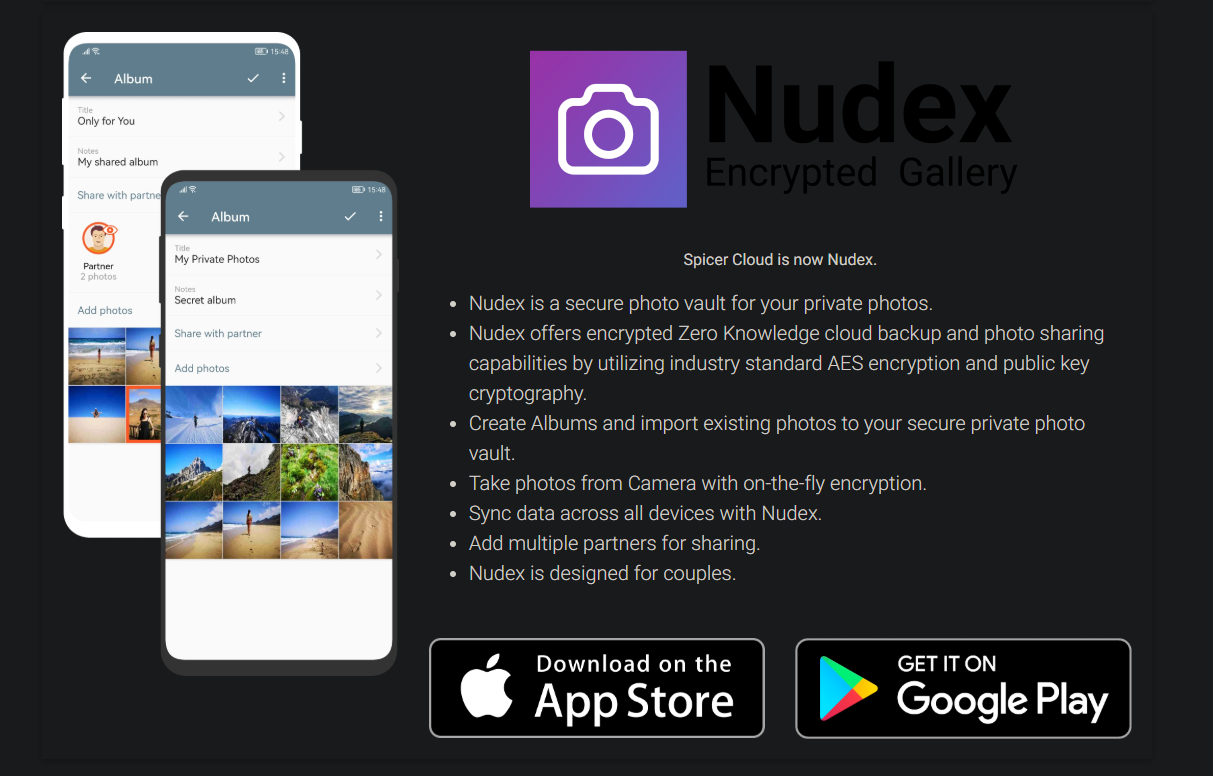
American People/Link
Before the internet was widely open services like this enabled connections. They had chat rooms, message boards, and smaller services none of which were interconnected.
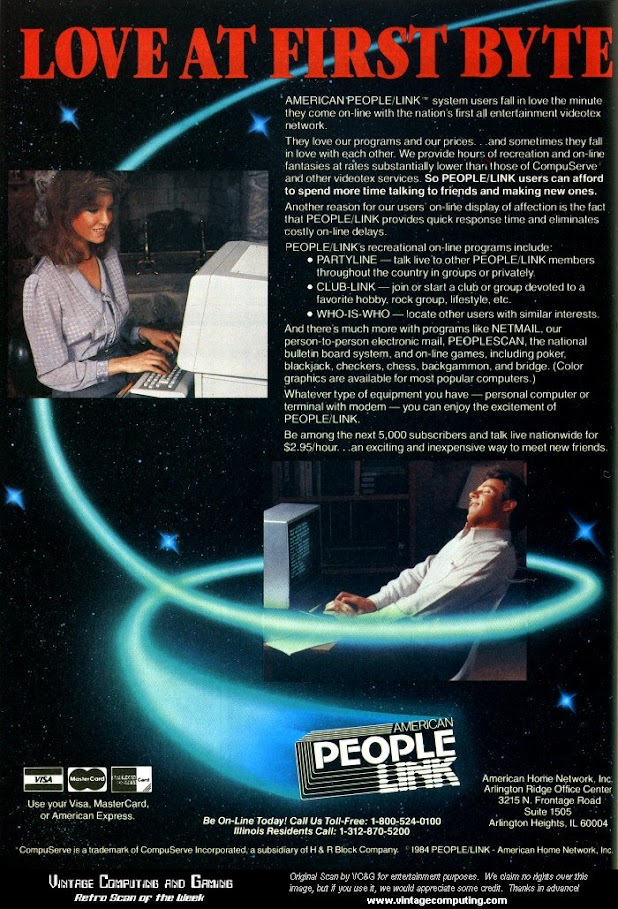
Rates were per-hour of use, with it being cheaper at night and weekends as there was no conflict with working business hours.
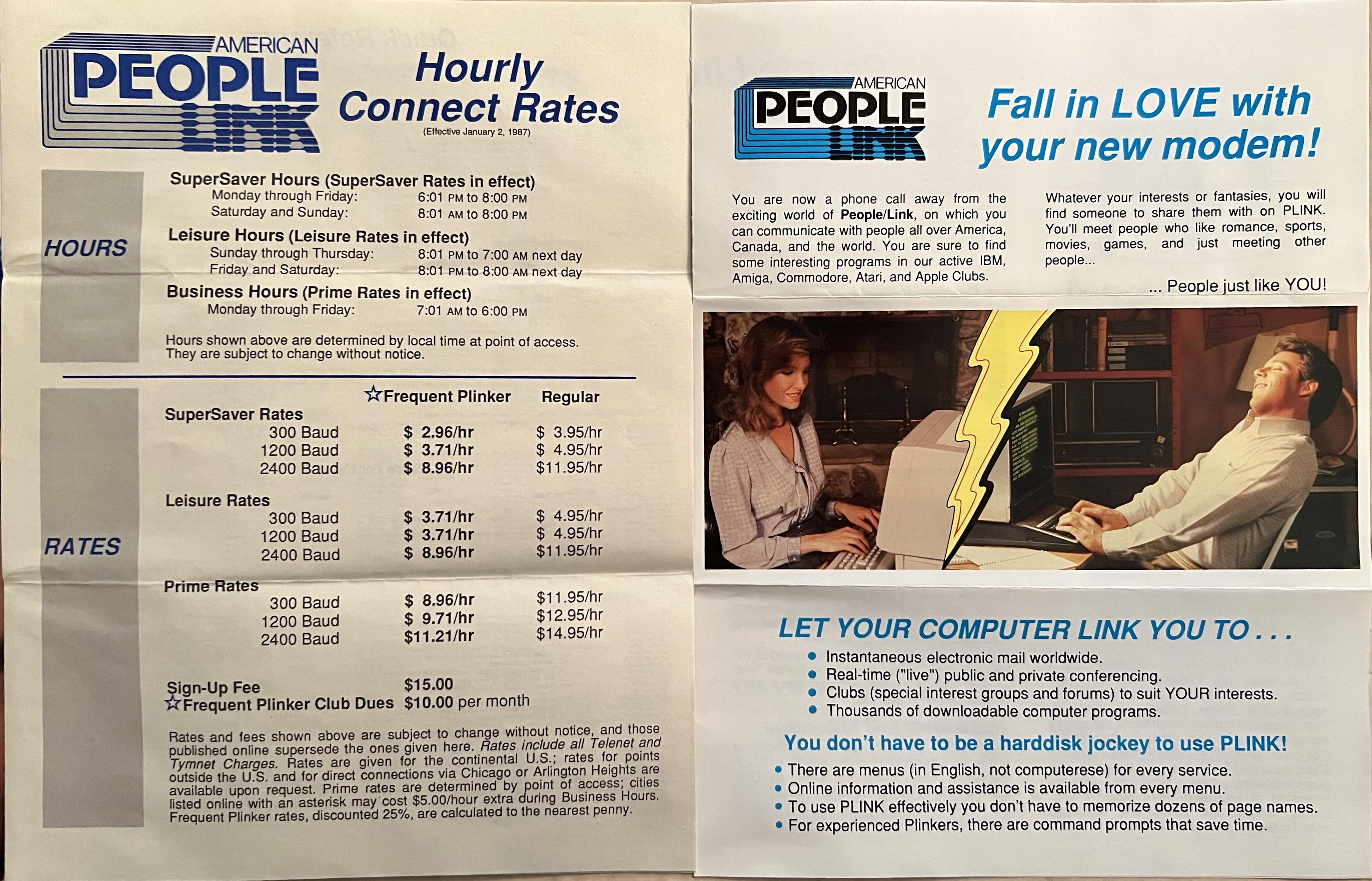 I see there’s a facebook group with currently 52 members
I see there’s a facebook group with currently 52 members
Facebook group for former members of the mid-to-late 1980s Chicago-based online social chat network “American People/Link”. People/Link was often called “Plink” for short, and members were known as “Plinkers”
Automaton
One of the drawings Maillardet’s automaton can make, the first of its kind is this scene.
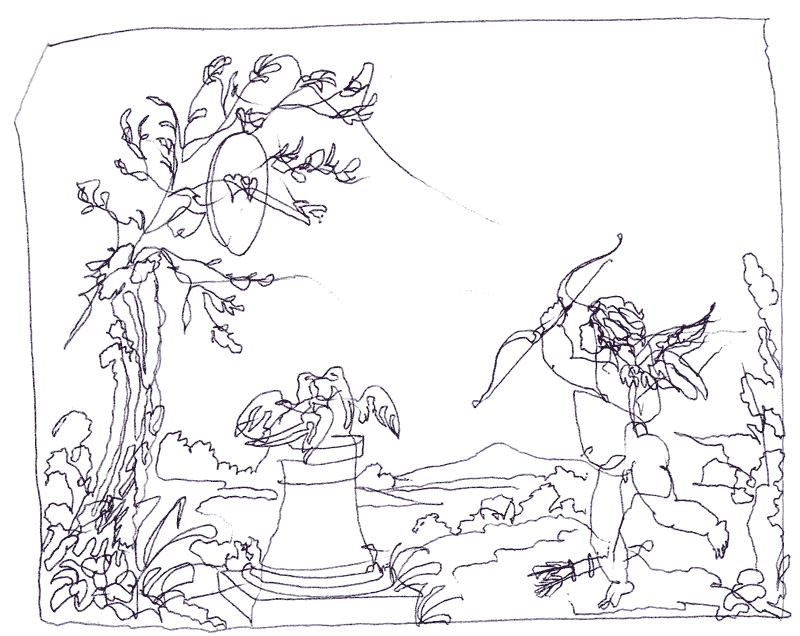
Tinder Antarctica
In 2013 a match occurred in Antarctica for the first time. They were a 45 minute helicopter ride apart.
“She was actually in her tent in the Dry Valleys when we matched,” said the scientist, who asked not to be named out of concern that the government would revoke his internet privileges if anyone found out he was using precious broadband to look for hookups. “She was quite literally camping in Antarctica, went on Tinder, and found me. It’s mind-blowing.”
YouTube as Dating Site
YouTube was initially conceived of as a dating site with the slogan, “Tune In, Hook Up.”
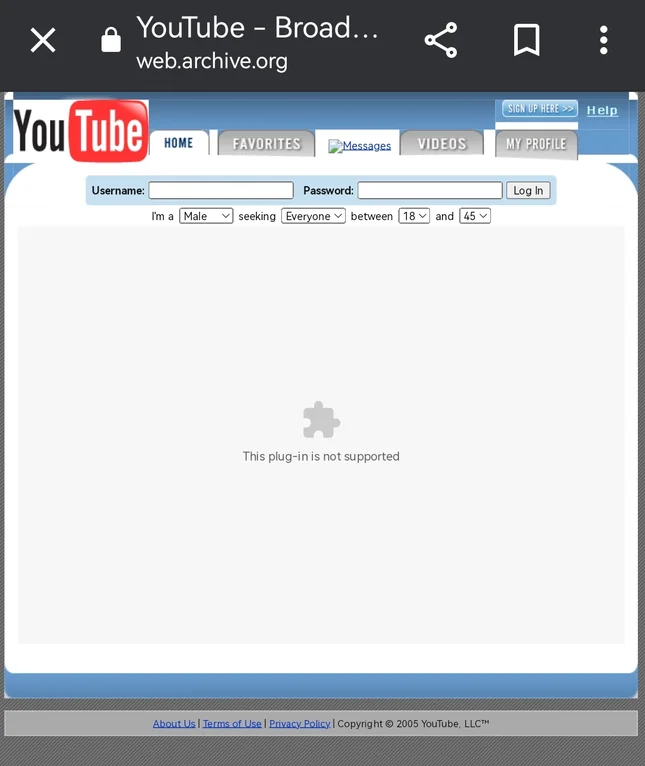
Valentine’s
The practice of sending valentines originated in the Middle Ages, with no link to Lupercalia, with boys drawing the names of girls at random. This custom was combated by priests, for example by Frances de Sales around 1600, apparently by replacing it with a religious custom of girls drawing the names of apostles from the altar.
The earliest description of February 14 as an annual celebration of love appears in the Charter of the Court of Love. The charter, allegedly issued by Charles VI of France at Mantes-la-Jolie in 1400, describes lavish festivities to be attended by several members of the royal court, including a feast, amorous song and poetry competitions, jousting and dancing. Amid these festivities, the attending ladies would hear and rule on disputes from lovers. No other record of the court exists, and none of those named in the charter were present at Mantes except Charles’s queen, Isabeau of Bavaria, who may well have imagined it all while waiting out a plague.
The Young Man’s Valentine Writer and Letters
1979, a British publisher issued this which contained sentimental verses which a young lover could use if unable to compose his own.
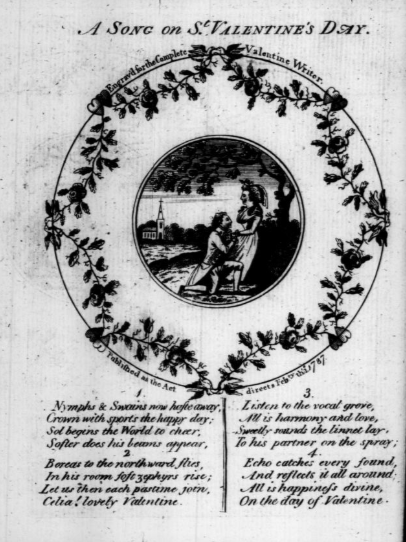
Containing, a variety of verses calculated to crown with mirth and good humor, the happy day which is called St. Valentine.
NOTE
Scanning the document it seems to follow the format of Love Letters Made Easy - Gabrielle Rosiere with headings like The GROCER to his SWEETHEART The FARMER to his SWEETHEART The DOCTOR to his SWEETHEART
The pains which I indure,
no medicine can cure;
no drug that I can find
can heal this love sick mind.
come feel my pulse my dear
and banish ev’ry fear;
unto my wish incline,
and be my Valentine
And following this, an answer in response.
Printers had already begun producing a limited number of cards with verses and sketches, called “mechanical valentines”
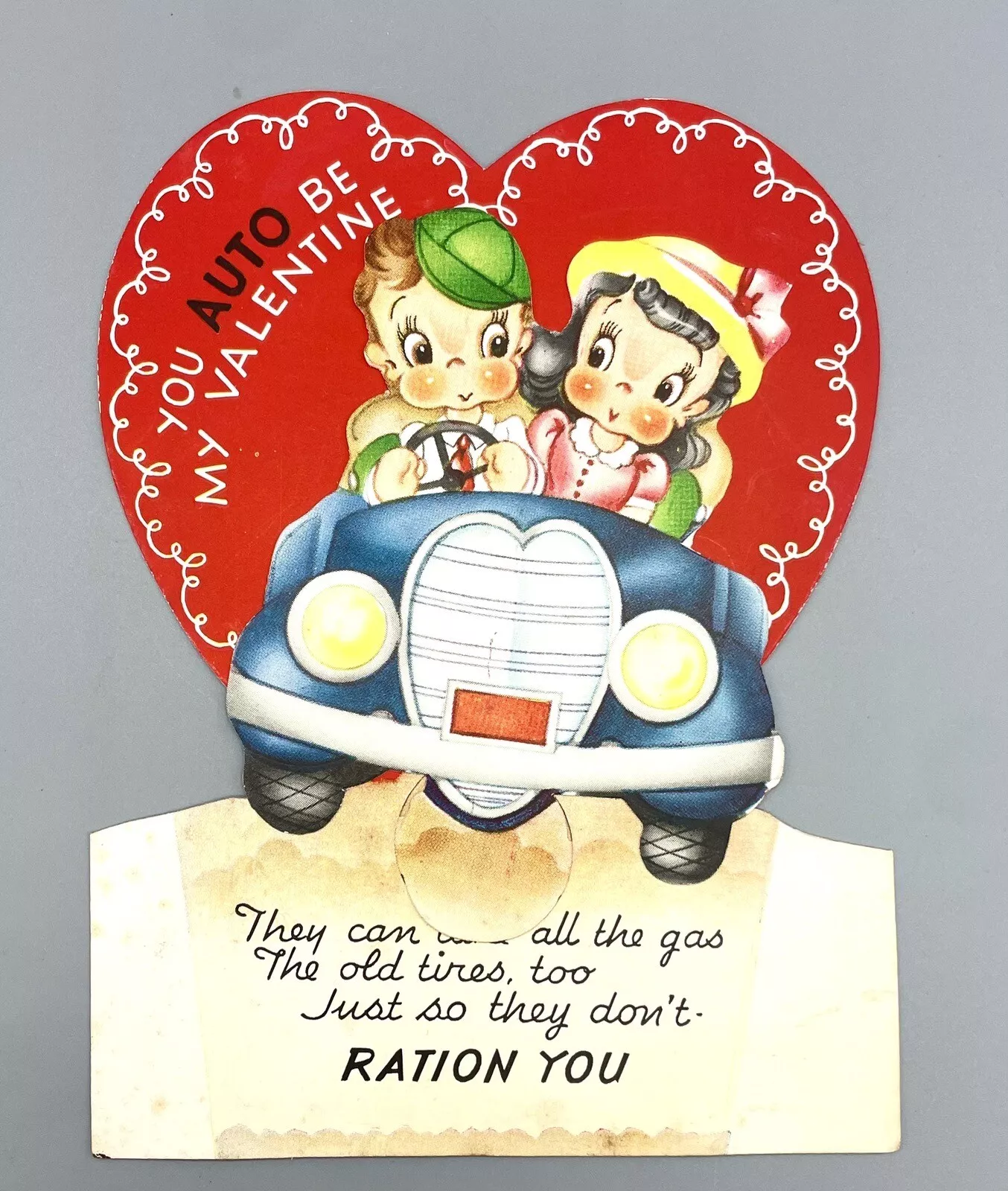
Reduction in postal rates and the introduction of the postal stamp in 1840, resulted in the ability to send messages anonymously, which was taken as a reason for the sudden appearance of racy exchanges. Production increased, “Cupid’s Manufactory” as Charles Dickens termed it, with over 3,000 women employed in manufacturing.
Date Like a Victorian
Date Like a Victorian - Courtship and Romance in the Victorian Era
created 2025-05-24, & modified,
=this.modifiedBy the beginning of the 19th century marriage around economic or social purposes was lessened by the value of marriage for mutual affection, satisfaction and love.
With this newfound freedom where the parents had less facilitation on the pairings, couples had to devise new ways of connecting. Some still met through parents, others with friends or neighbors. Others through work and social events.
More often than gifts, however, couples wrote each other letters. As they were sometimes separated for long periods of time during their engagements because of work and familial obligations, letters were the main source of communication. Many relationships developed in a large part through the written word.
Lindsay Companionate Marriage
Companionate marriage was a term popularized by Judge Ben B. Lindsay in his 1927 book of the same name. This type of marriage embraced a modern egalitarian idea, where couples controlled their fertility and rejected patriarchal family models, envisioning marriage as an equal partnership committed to the fulfillment of each individual’s emotional and sexual needs.
He suggested that young men and women should be able to live a trial marriage, and have a year to understand if they were suitable for one another, with the caveat that they’d not have children during this period.
He was accused of,
Link to originalpromoting immorality, promiscuity and free love, charges that he denied. At one point, even the Pope spoke out against him. Bertrand Russell, in his 1929 book Marriage and Morals, wrote approvingly of Lindsey’s proposals but observed that they “were received with a howl of horror by all middle-aged persons and most of the newspapers throughout the length and breadth of America.” In Denver, he was ousted from the bench, after 28 years of service. Time expressed the view that his views on companionate marriage had destroyed his reputation.
Nintendo Love Tester
Before famously creating games, Nintendo devised technologies with creative and experimental designs. One, from 1969 was the Nintendo Love Tester 1969.
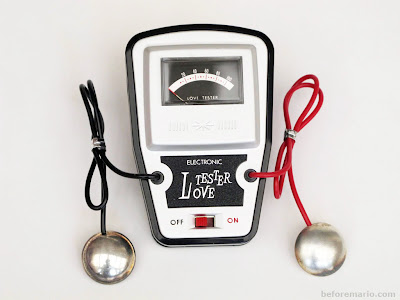
Gunpei Yokoi designed the Love Testers in the late sixties. When promoting the product, he jokingly stated that if the man kisses the woman while “testing their love,” they’d get a better result. Of course this was not true. In a commercial that aired on television, a woman and man tested each others love and got a poor score. Following this, another man came along to try it out, and got a very high score. The commercial ended with the two falling in love and kissing.
It came with a black pouch (to be carried.)

The device was simple and likely only measured the level of conductivity of the couple. This was interpreted as the “level of love” and relayed on a scale of 0 to 100.
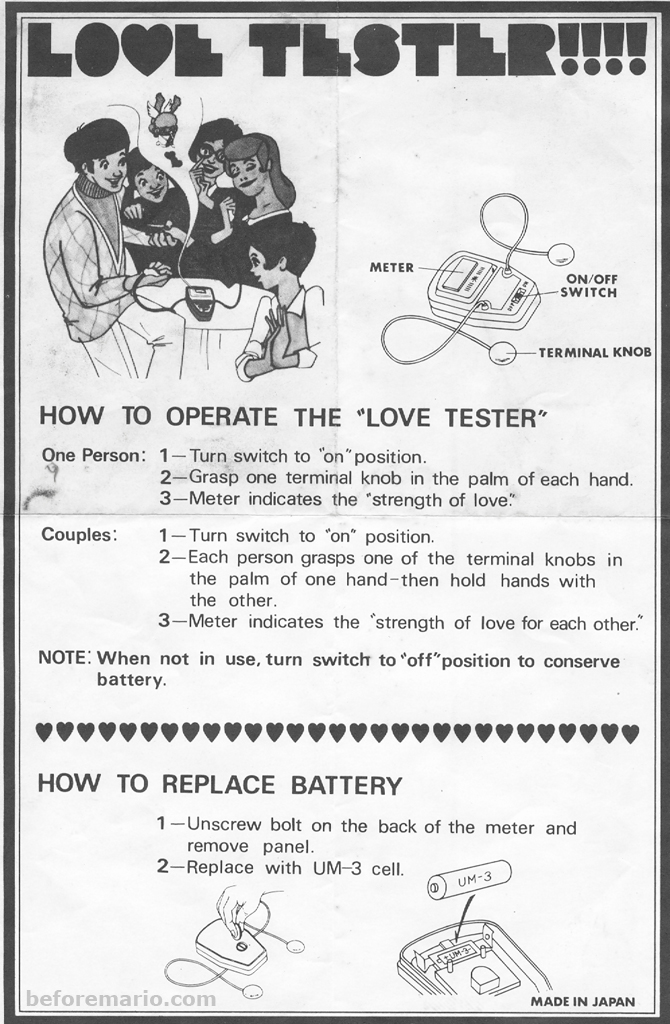
It also seems to indicate that one person could use the device, indicating the strength of “love ability”
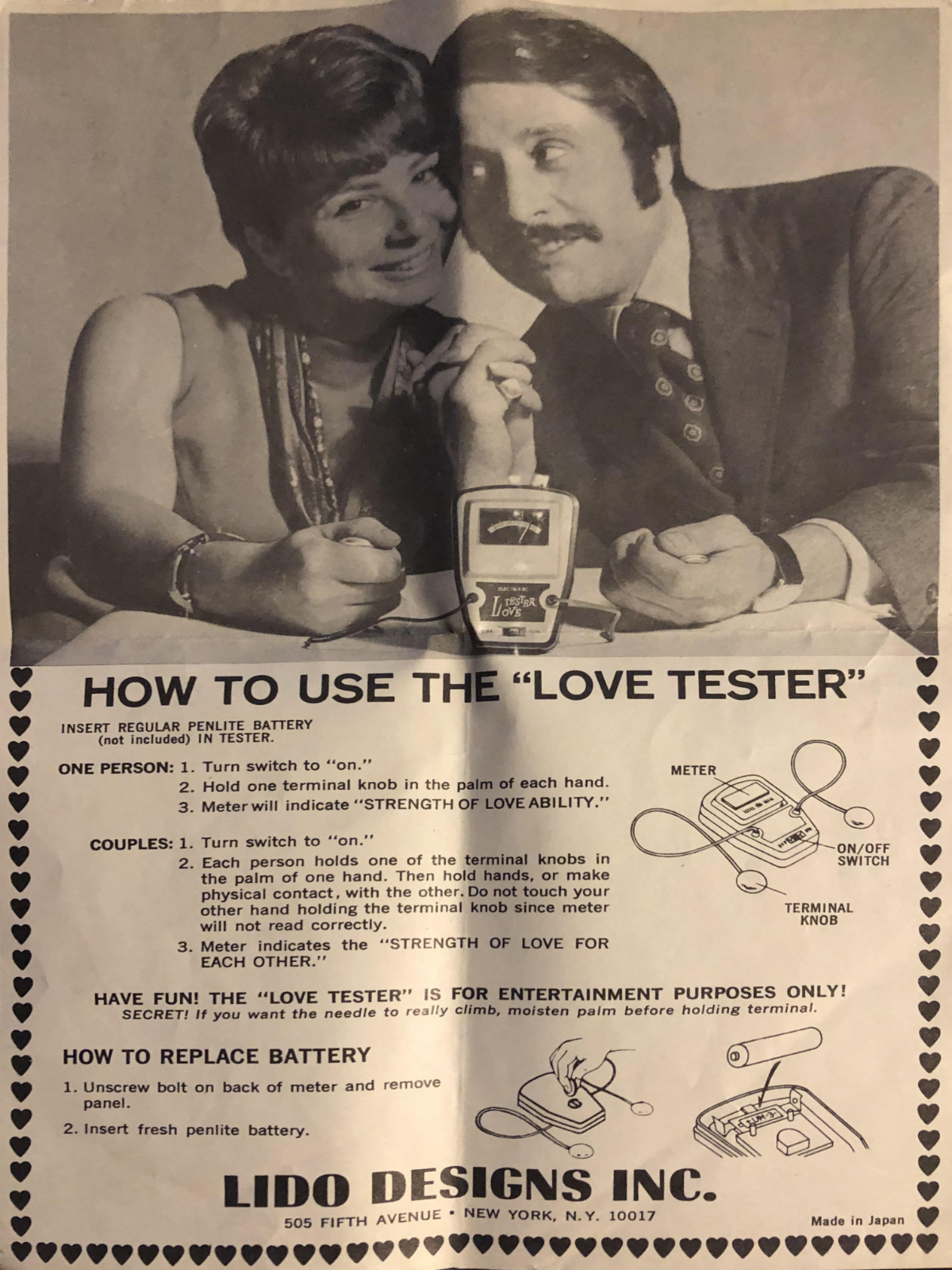
Gunpei: “The Love Tester came from me wondering if I could somehow use this to get girls to hold my hand. … I wound up holding hands with quite a few girls thanks to it. Of course, somewhere along the line I started to feel like I wanted to do more than just hold hands. [laughs]”
Thought
Nintendo also had a product called Companion that was basically a walkie talkie pair, and which on the packaging depicted a young boy and girl communicating.
Love Testers
General love tester kits exist, like Elenco AK-500 Love Tester
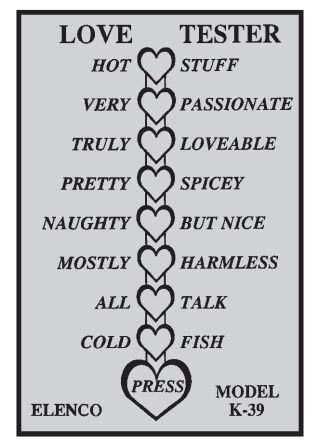
Want to know what kind of lover you are? Push the PRESS button and the Love Tester will rate you as a lover. The Love Tester has eight Light Emitting Diodes (LEDs) that are driven ON and OFF one at a time in sequence. When the PRESS button is pushed, the LEDs will flash and the buzzer will sound. After a brief period of time, only one LED will remain lit. Above the lit LED is your rating as a lover, anywhere from Cold Fish to Hot Stuff. In a minute or two, the LED will get dim and gradually go out.
This device seems to mimic a fictional device from the television show the Simpsons.
When Moe’s closed Barney lost his only means of support — sucking coins out of the love tester machine.
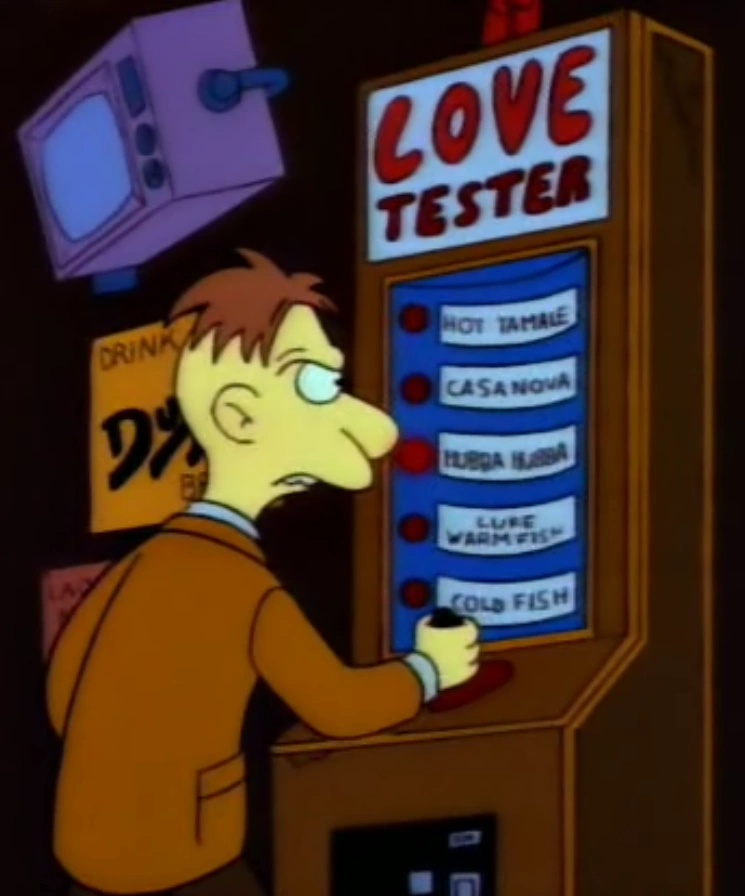
The machine rates all users poorly, and they get frustrated with the results. The one exception is an English character, Lily Marleen, who has everyone in love with her but Homer and it rates her “Irresistible to All.” Homer does not love her, so she returns to the UK where she gets with a Homer-lookalike.
Love Testers of this type were popular in arcades/bars. They are also called love meters and love tellers and once money is inserted, they rate the subject’s sex appeal, love abilities or romantic feelings towards someone.
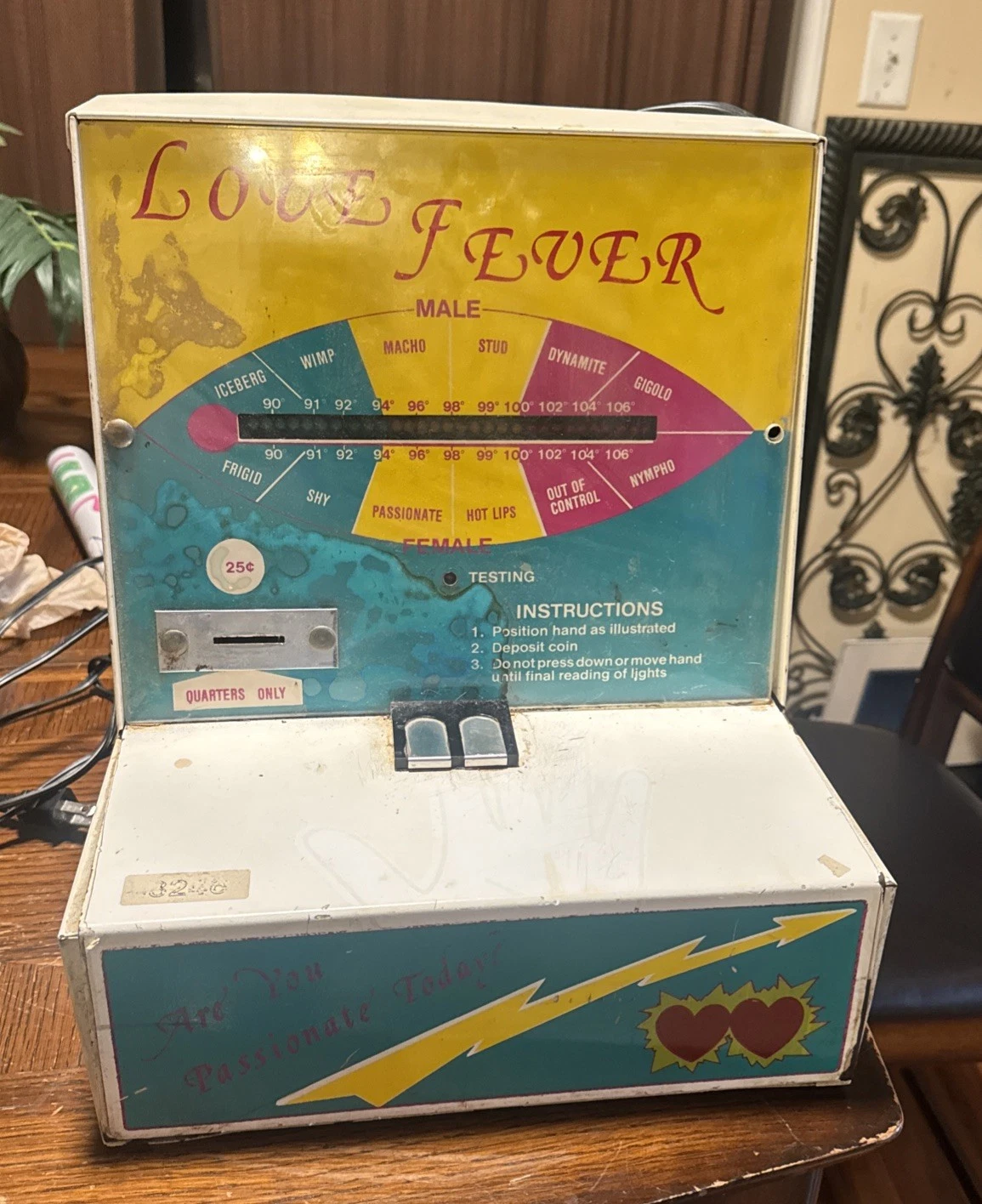
Some work by measuring the moisture on the skin of the subject hands by electrically testing skin conductance and rates accordingly.
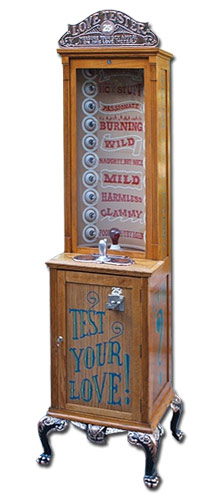
Lonely Hearts Ad - Personal Advertisement
Many Victorian and Edwardian couples met via newspaper advertisements called Lonely Hearts Ads.
The first:
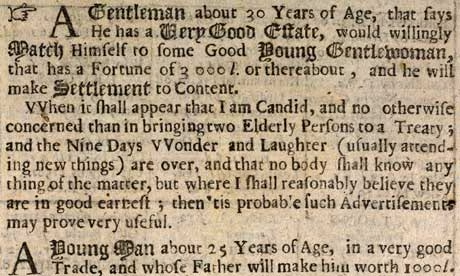
The first known ad, published in 1695, listed the female attributes required by a demanding gentleman, most notably wealth. Early ads were forthright in their search for a wife with “a Fortune of 3000 [pounds] or thereabout.” Lest we find this ad unusually mercenary, we do well to remember that a person’s fortune was usually common knowledge and that newspapers often printed at the end of the wedding announcement the sum that a woman brought to the marriage. But from the mid-eighteenth century onward romantic love was emphasized over practical considerations, following the model found in sentimental novels. More and more often during the second half of the eighteenth century the ads placed by men expressed their hope to find a woman with a “feeling” or “tender” heart, attributes considered the province of women, though some men, too, described their own hearts as “full of affection, sensibility, and delicacy.”
These personals have also been used by criminals – con artists, fraudsters and killers – to lure victims.
The earliest advertisements of this type were satirical, including one by brothers James and Benjamin Franklin (president) who ridiculed those who married for money.
Silence Dogwood
Silence Dogwood was the pen name used by Franklin to get his work published in the New-England Courant newspaper, founded and published by his brother James.
The persona of Silence Dogwood was a middle-aged widow. Once every two weeks at age of 16, he would leave a letter under the door of his brother’s printing shop.
The letters were published in The New-England Courant fortnightly, and amused readers. Some men wrote in offering to marry Ms. Dogood, upon learning she was widowed
In a deeper digression, I try to find books on catfishing, as in adopting a false online persona. This book is unrelated, but I suddenly want it.
In the United States during the Civil War, soldiers and sailors placed personal ads – and for a woman to reply to these ads was considered a patriotic act. Many military men and their correspondents formed romantic relationships.
The Lonely Hearts clubs began forming in the 20th century in the United States. Clubs accepted members for an enrollment fee, and published papers dedicated to member ads or compiled lists and catalogs of ads that were mailed to members.
There were at least 500 lonely hearts clubs by 1961, with membership estimates between 100,000 and 4 million. Club operators referred to themselves as “marriage brokers”. As computer dating and single clubs became available, lonely hearts clubs diminished
Early ads placed an emphasis on economic factors, but by the end of the 18th century ads revealed an interest in romantic love.
Further on Lonely Hearts reading here Shapely Ankle Preferr’d by Francesca Beauman.
I also find there’s a digital version with a tagline that says “find love the old fashioned way”.
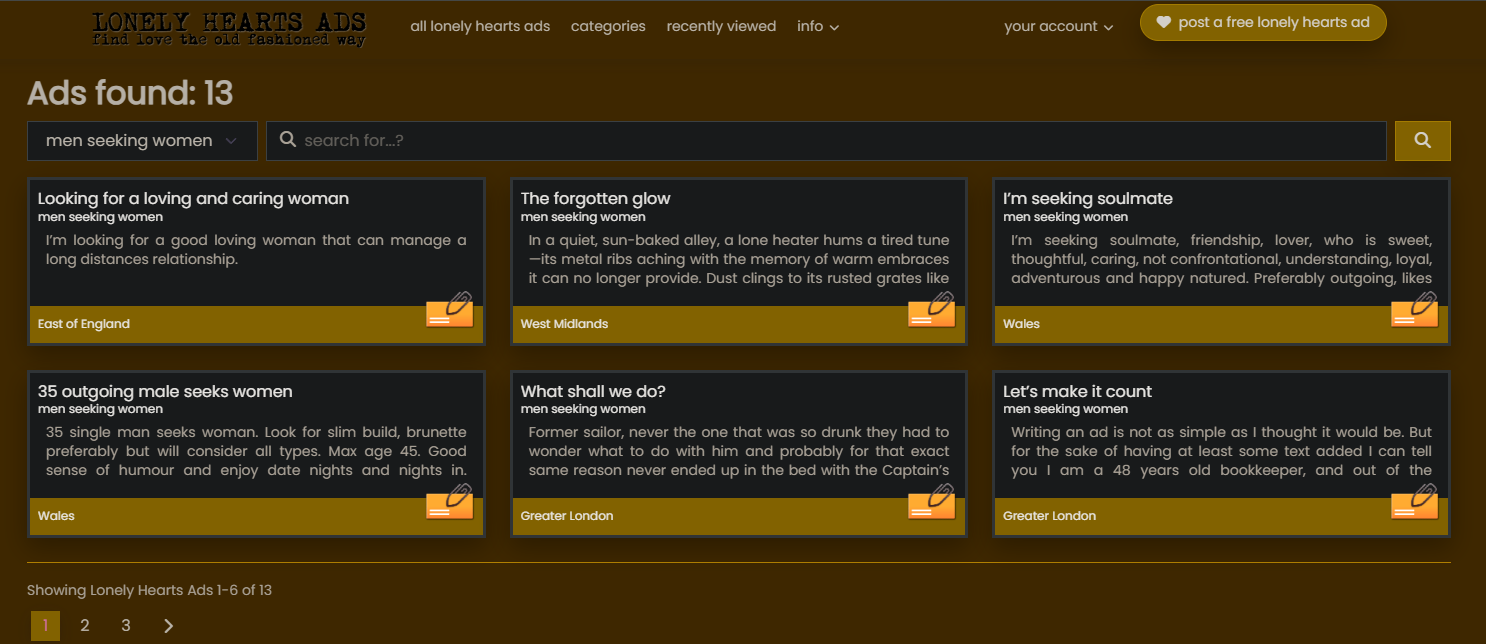
Scanning them, they seem tremendously romantic!

